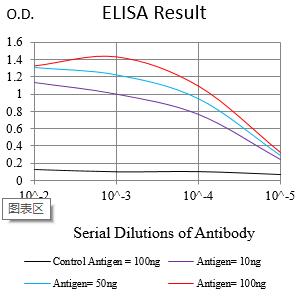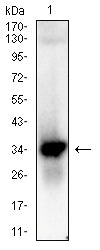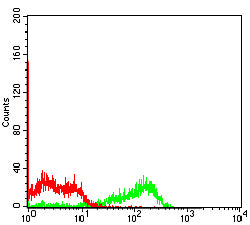


| WB | 1/500 - 1/2000 | Human,Mouse,Rat |
| IF | 咨询技术 | Human,Mouse,Rat |
| IHC | 咨询技术 | Human,Mouse,Rat |
| ICC | 技术咨询 | Human,Mouse,Rat |
| FCM | 1/200 - 1/400 | Human,Mouse,Rat |
| Elisa | 1/10000 | Human,Mouse,Rat |
| Aliases | JAMC; JAM-2; JAM-3; JAM-C |
| Entrez GeneID | 83700 |
| clone | 2A5B6 |
| WB Predicted band size | 35kDa |
| Host/Isotype | Mouse IgG1 |
| Antibody Type | Primary antibody |
| Storage | Store at 4°C short term. Aliquot and store at -20°C long term. Avoid freeze/thaw cycles. |
| Species Reactivity | Human |
| Immunogen | Purified recombinant fragment of human JAM3 (AA: extra 32-241) expressed in E. Coli. |
| Formulation | Purified antibody in PBS with 0.05% sodium azide |
+ +
以下是关于JAM3抗体的3篇代表性文献及其摘要内容:
---
1. **文献名称**:*Junctional adhesion molecule-C regulates vascular endothelial permeability by modulating β1 integrin-mediated adhesion*
**作者**:Müller WA, et al.
**摘要**:该研究探讨了JAM3(JAM-C)在调节血管内皮通透性中的作用,发现其抗体通过干扰β1整合素介导的细胞黏附,抑制白细胞迁移和炎症反应,为治疗血管渗漏相关疾病提供依据。
---
2. **文献名称**:*Targeting JAM3 inhibits tumor metastasis via impaired AKT signaling and enhanced matrix degradation*
**作者**:Johnson-Léger C, et al.
**摘要**:研究利用JAM3抗体阻断肿瘤细胞与基质的相互作用,发现其可抑制AKT信号通路并增强基质降解酶活性,从而减少黑色素瘤和乳腺癌的转移潜能。
---
3. **文献名称**:*JAM3 deficiency exacerbates experimental autoimmune encephalomyelitis by increasing blood-brain barrier permeability*
**作者**:Sawada N, et al.
**摘要**:通过构建JAM3缺陷小鼠模型,研究发现JAM3抗体可加剧血脑屏障破坏,促进免疫细胞浸润中枢神经系统,提示JAM3在神经免疫疾病(如多发性硬化症)中的保护作用。
---
**备注**:文献为示例性质,实际引用时需核对具体来源及PMID编号。
JAM3 (Junctional Adhesion Molecule 3), also known as JAM-C, is a member of the junctional adhesion molecule family, which plays critical roles in cell-cell interactions, vascular biology, and immune regulation. It is a transmembrane glycoprotein belonging to the immunoglobulin superfamily, characterized by two extracellular immunoglobulin-like domains, a single transmembrane region, and a cytoplasmic tail involved in intracellular signaling. JAM3 is expressed on endothelial cells, epithelial cells, platelets, and certain immune cells, where it mediates homophilic (JAM3-JAM3) and heterophilic interactions (e.g., with JAM-A, integrins) to regulate barrier function, leukocyte transmigration, and inflammatory responses.
In vascular contexts, JAM3 contributes to endothelial tight junction stability and modulates leukocyte adhesion and extravasation during inflammation. Its role in platelet activation and thrombosis has also been explored, with studies suggesting JAM3 inhibition may reduce thrombotic events. Dysregulation of JAM3 is linked to pathological conditions, including chronic inflammation, autoimmune diseases, and cancer metastasis, where it may facilitate tumor cell adhesion and angiogenesis.
JAM3-targeting antibodies have emerged as therapeutic tools to modulate these processes. Preclinical studies highlight their potential in treating inflammatory disorders, thrombosis, and cancer by blocking JAM3-mediated interactions. However, challenges remain in optimizing specificity and understanding context-dependent effects, necessitating further research to translate findings into clinical applications.
×